Organizational Behavior Case Study: Regency Grand Hotel, BUS8020
VerifiedAdded on 2022/08/18
|12
|2245
|44
Case Study
AI Summary
This case study analyzes the Regency Grand Hotel, a five-star lodge facing challenges after implementing new employee empowerment practices under General Manager Becker. The study delves into organizational behavior theories, highlighting issues arising from a lack of focus, leadership, and collaboration. The hotel experienced a decline in performance, guest complaints, and employee dissatisfaction. The analysis identifies problems such as employee misuse of power, increased absenteeism, internal politics, and a lack of understanding of business affairs. The study recommends HR interventions, policy changes, and modifications to the organizational structure to address these issues. It explores the pros and cons of proposed solutions, including time management, organizational discipline, and the potential costs of restructuring. The report concludes by emphasizing the importance of a balanced approach to employee empowerment that considers both employee needs and organizational integrity.
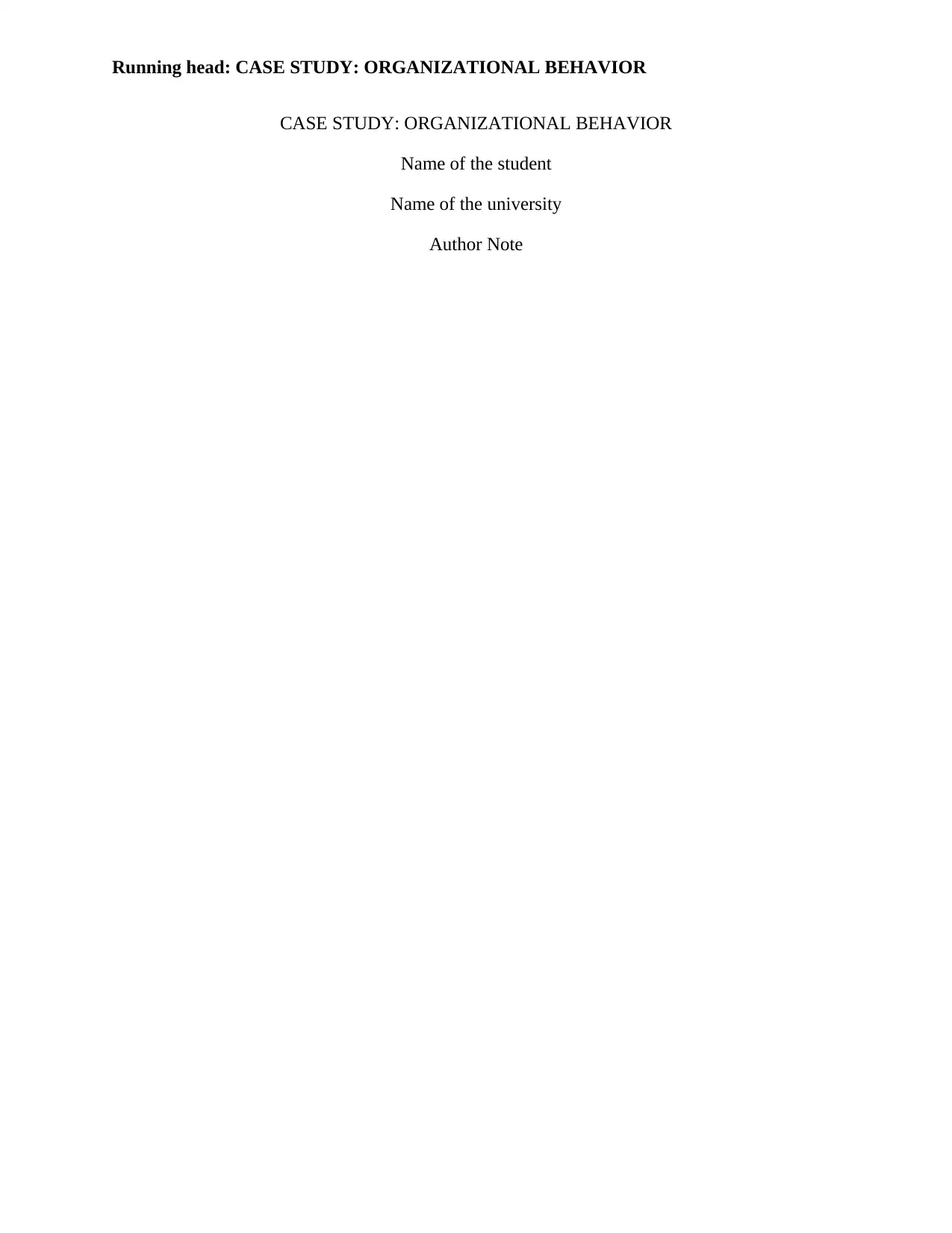
Running head: CASE STUDY: ORGANIZATIONAL BEHAVIOR
CASE STUDY: ORGANIZATIONAL BEHAVIOR
Name of the student
Name of the university
Author Note
CASE STUDY: ORGANIZATIONAL BEHAVIOR
Name of the student
Name of the university
Author Note
Paraphrase This Document
Need a fresh take? Get an instant paraphrase of this document with our AI Paraphraser
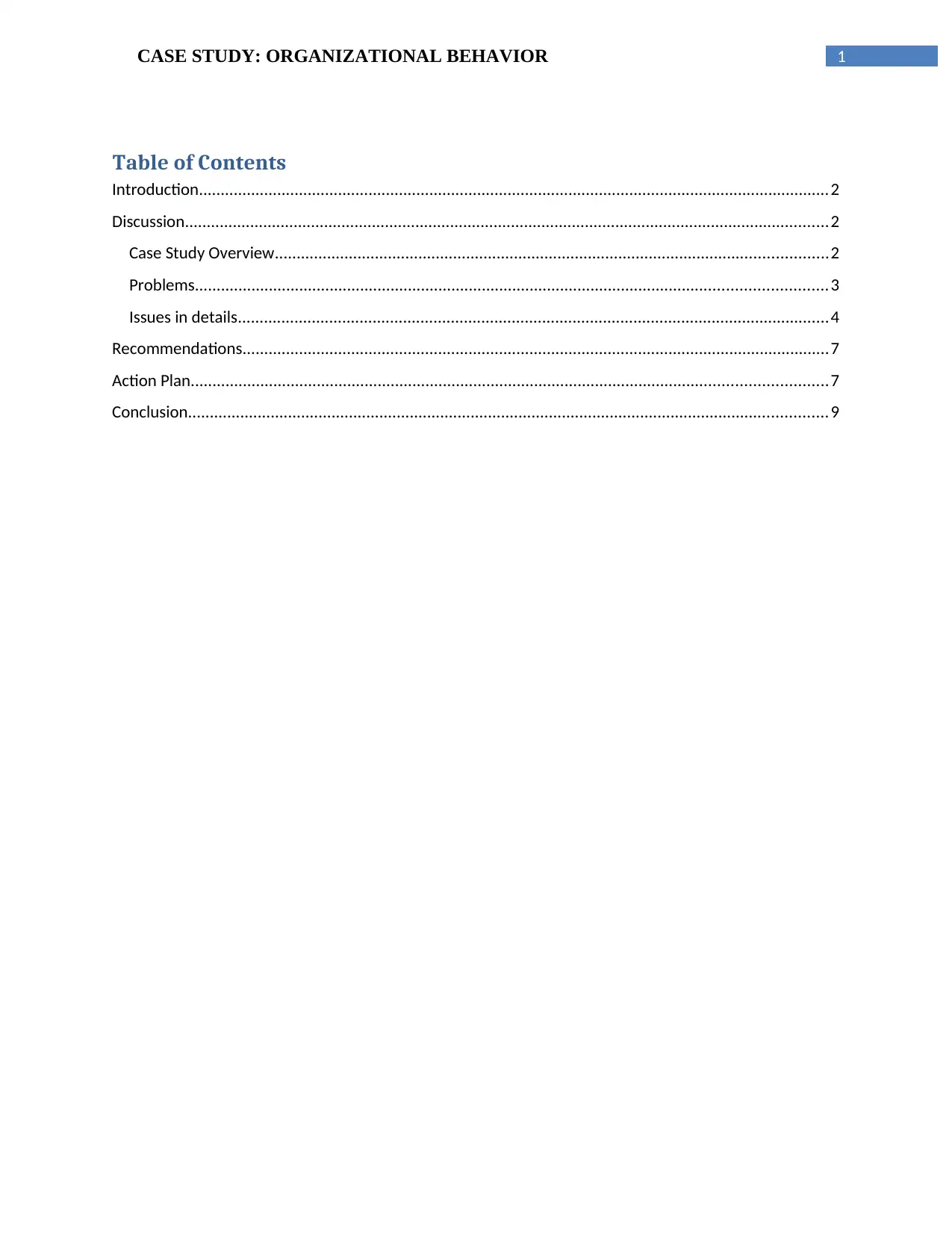
1CASE STUDY: ORGANIZATIONAL BEHAVIOR
Table of Contents
Introduction.................................................................................................................................................2
Discussion....................................................................................................................................................2
Case Study Overview...............................................................................................................................2
Problems.................................................................................................................................................3
Issues in details........................................................................................................................................4
Recommendations.......................................................................................................................................7
Action Plan..................................................................................................................................................7
Conclusion...................................................................................................................................................9
Table of Contents
Introduction.................................................................................................................................................2
Discussion....................................................................................................................................................2
Case Study Overview...............................................................................................................................2
Problems.................................................................................................................................................3
Issues in details........................................................................................................................................4
Recommendations.......................................................................................................................................7
Action Plan..................................................................................................................................................7
Conclusion...................................................................................................................................................9
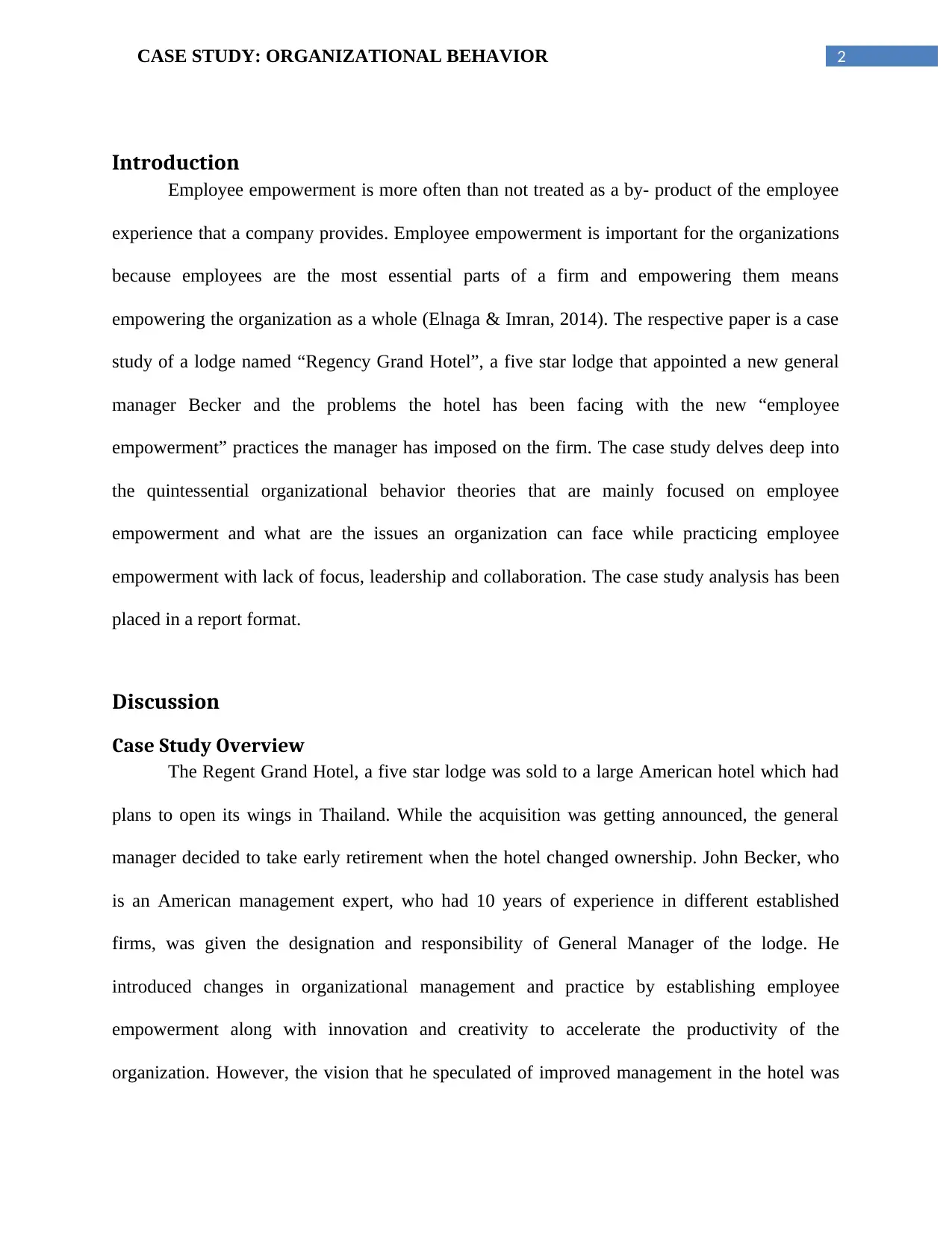
2CASE STUDY: ORGANIZATIONAL BEHAVIOR
Introduction
Employee empowerment is more often than not treated as a by- product of the employee
experience that a company provides. Employee empowerment is important for the organizations
because employees are the most essential parts of a firm and empowering them means
empowering the organization as a whole (Elnaga & Imran, 2014). The respective paper is a case
study of a lodge named “Regency Grand Hotel”, a five star lodge that appointed a new general
manager Becker and the problems the hotel has been facing with the new “employee
empowerment” practices the manager has imposed on the firm. The case study delves deep into
the quintessential organizational behavior theories that are mainly focused on employee
empowerment and what are the issues an organization can face while practicing employee
empowerment with lack of focus, leadership and collaboration. The case study analysis has been
placed in a report format.
Discussion
Case Study Overview
The Regent Grand Hotel, a five star lodge was sold to a large American hotel which had
plans to open its wings in Thailand. While the acquisition was getting announced, the general
manager decided to take early retirement when the hotel changed ownership. John Becker, who
is an American management expert, who had 10 years of experience in different established
firms, was given the designation and responsibility of General Manager of the lodge. He
introduced changes in organizational management and practice by establishing employee
empowerment along with innovation and creativity to accelerate the productivity of the
organization. However, the vision that he speculated of improved management in the hotel was
Introduction
Employee empowerment is more often than not treated as a by- product of the employee
experience that a company provides. Employee empowerment is important for the organizations
because employees are the most essential parts of a firm and empowering them means
empowering the organization as a whole (Elnaga & Imran, 2014). The respective paper is a case
study of a lodge named “Regency Grand Hotel”, a five star lodge that appointed a new general
manager Becker and the problems the hotel has been facing with the new “employee
empowerment” practices the manager has imposed on the firm. The case study delves deep into
the quintessential organizational behavior theories that are mainly focused on employee
empowerment and what are the issues an organization can face while practicing employee
empowerment with lack of focus, leadership and collaboration. The case study analysis has been
placed in a report format.
Discussion
Case Study Overview
The Regent Grand Hotel, a five star lodge was sold to a large American hotel which had
plans to open its wings in Thailand. While the acquisition was getting announced, the general
manager decided to take early retirement when the hotel changed ownership. John Becker, who
is an American management expert, who had 10 years of experience in different established
firms, was given the designation and responsibility of General Manager of the lodge. He
introduced changes in organizational management and practice by establishing employee
empowerment along with innovation and creativity to accelerate the productivity of the
organization. However, the vision that he speculated of improved management in the hotel was
⊘ This is a preview!⊘
Do you want full access?
Subscribe today to unlock all pages.

Trusted by 1+ million students worldwide
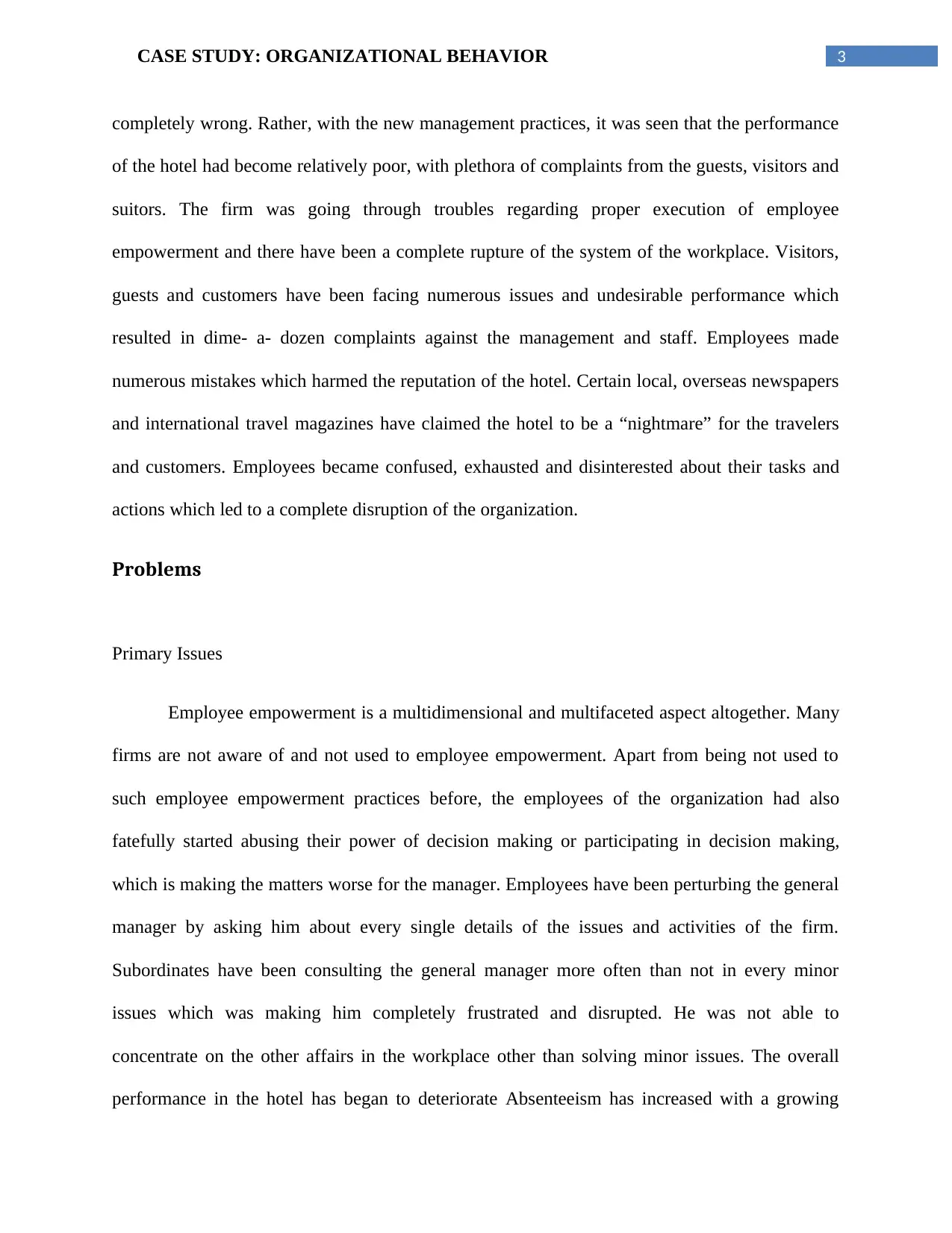
3CASE STUDY: ORGANIZATIONAL BEHAVIOR
completely wrong. Rather, with the new management practices, it was seen that the performance
of the hotel had become relatively poor, with plethora of complaints from the guests, visitors and
suitors. The firm was going through troubles regarding proper execution of employee
empowerment and there have been a complete rupture of the system of the workplace. Visitors,
guests and customers have been facing numerous issues and undesirable performance which
resulted in dime- a- dozen complaints against the management and staff. Employees made
numerous mistakes which harmed the reputation of the hotel. Certain local, overseas newspapers
and international travel magazines have claimed the hotel to be a “nightmare” for the travelers
and customers. Employees became confused, exhausted and disinterested about their tasks and
actions which led to a complete disruption of the organization.
Problems
Primary Issues
Employee empowerment is a multidimensional and multifaceted aspect altogether. Many
firms are not aware of and not used to employee empowerment. Apart from being not used to
such employee empowerment practices before, the employees of the organization had also
fatefully started abusing their power of decision making or participating in decision making,
which is making the matters worse for the manager. Employees have been perturbing the general
manager by asking him about every single details of the issues and activities of the firm.
Subordinates have been consulting the general manager more often than not in every minor
issues which was making him completely frustrated and disrupted. He was not able to
concentrate on the other affairs in the workplace other than solving minor issues. The overall
performance in the hotel has began to deteriorate Absenteeism has increased with a growing
completely wrong. Rather, with the new management practices, it was seen that the performance
of the hotel had become relatively poor, with plethora of complaints from the guests, visitors and
suitors. The firm was going through troubles regarding proper execution of employee
empowerment and there have been a complete rupture of the system of the workplace. Visitors,
guests and customers have been facing numerous issues and undesirable performance which
resulted in dime- a- dozen complaints against the management and staff. Employees made
numerous mistakes which harmed the reputation of the hotel. Certain local, overseas newspapers
and international travel magazines have claimed the hotel to be a “nightmare” for the travelers
and customers. Employees became confused, exhausted and disinterested about their tasks and
actions which led to a complete disruption of the organization.
Problems
Primary Issues
Employee empowerment is a multidimensional and multifaceted aspect altogether. Many
firms are not aware of and not used to employee empowerment. Apart from being not used to
such employee empowerment practices before, the employees of the organization had also
fatefully started abusing their power of decision making or participating in decision making,
which is making the matters worse for the manager. Employees have been perturbing the general
manager by asking him about every single details of the issues and activities of the firm.
Subordinates have been consulting the general manager more often than not in every minor
issues which was making him completely frustrated and disrupted. He was not able to
concentrate on the other affairs in the workplace other than solving minor issues. The overall
performance in the hotel has began to deteriorate Absenteeism has increased with a growing
Paraphrase This Document
Need a fresh take? Get an instant paraphrase of this document with our AI Paraphraser
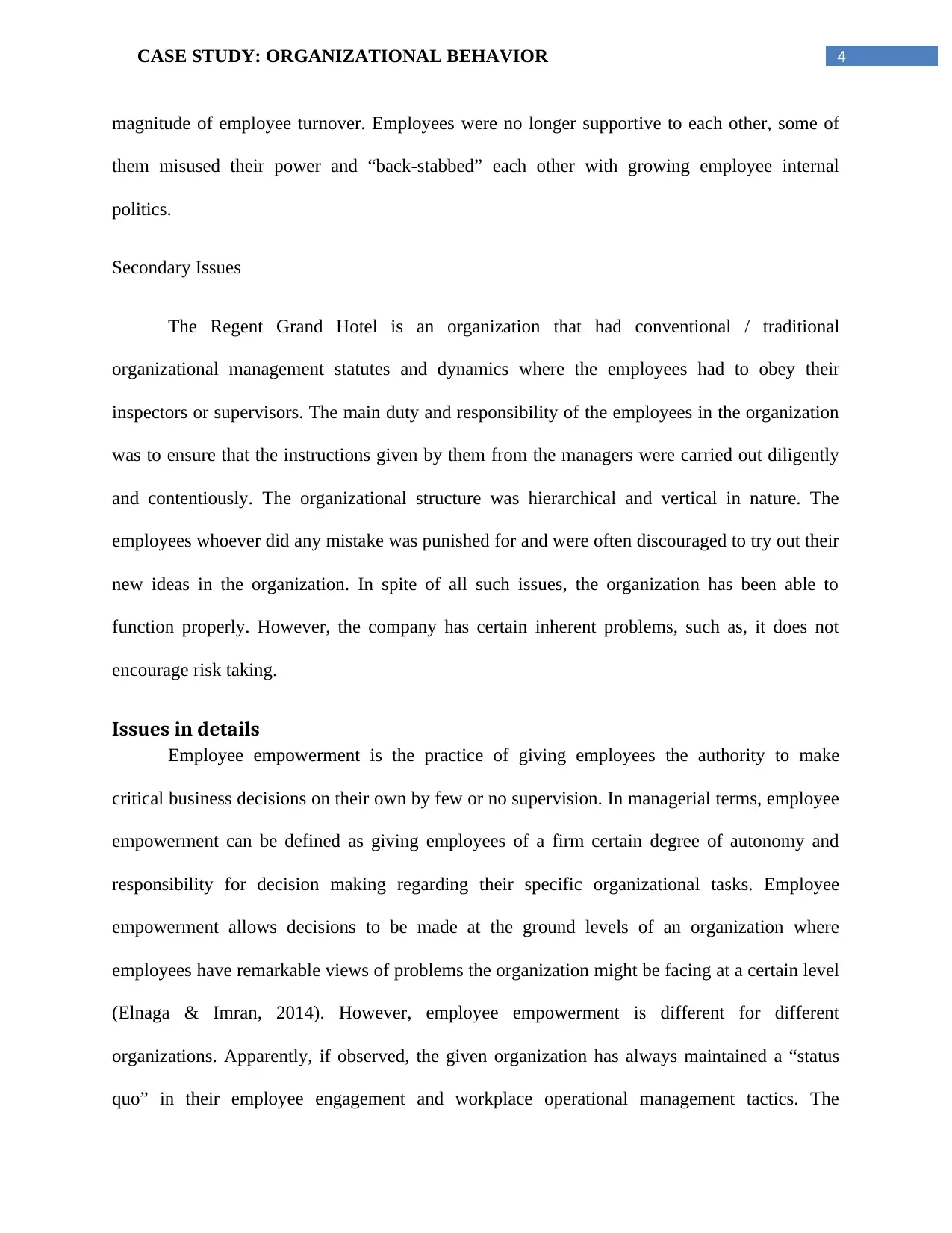
4CASE STUDY: ORGANIZATIONAL BEHAVIOR
magnitude of employee turnover. Employees were no longer supportive to each other, some of
them misused their power and “back-stabbed” each other with growing employee internal
politics.
Secondary Issues
The Regent Grand Hotel is an organization that had conventional / traditional
organizational management statutes and dynamics where the employees had to obey their
inspectors or supervisors. The main duty and responsibility of the employees in the organization
was to ensure that the instructions given by them from the managers were carried out diligently
and contentiously. The organizational structure was hierarchical and vertical in nature. The
employees whoever did any mistake was punished for and were often discouraged to try out their
new ideas in the organization. In spite of all such issues, the organization has been able to
function properly. However, the company has certain inherent problems, such as, it does not
encourage risk taking.
Issues in details
Employee empowerment is the practice of giving employees the authority to make
critical business decisions on their own by few or no supervision. In managerial terms, employee
empowerment can be defined as giving employees of a firm certain degree of autonomy and
responsibility for decision making regarding their specific organizational tasks. Employee
empowerment allows decisions to be made at the ground levels of an organization where
employees have remarkable views of problems the organization might be facing at a certain level
(Elnaga & Imran, 2014). However, employee empowerment is different for different
organizations. Apparently, if observed, the given organization has always maintained a “status
quo” in their employee engagement and workplace operational management tactics. The
magnitude of employee turnover. Employees were no longer supportive to each other, some of
them misused their power and “back-stabbed” each other with growing employee internal
politics.
Secondary Issues
The Regent Grand Hotel is an organization that had conventional / traditional
organizational management statutes and dynamics where the employees had to obey their
inspectors or supervisors. The main duty and responsibility of the employees in the organization
was to ensure that the instructions given by them from the managers were carried out diligently
and contentiously. The organizational structure was hierarchical and vertical in nature. The
employees whoever did any mistake was punished for and were often discouraged to try out their
new ideas in the organization. In spite of all such issues, the organization has been able to
function properly. However, the company has certain inherent problems, such as, it does not
encourage risk taking.
Issues in details
Employee empowerment is the practice of giving employees the authority to make
critical business decisions on their own by few or no supervision. In managerial terms, employee
empowerment can be defined as giving employees of a firm certain degree of autonomy and
responsibility for decision making regarding their specific organizational tasks. Employee
empowerment allows decisions to be made at the ground levels of an organization where
employees have remarkable views of problems the organization might be facing at a certain level
(Elnaga & Imran, 2014). However, employee empowerment is different for different
organizations. Apparently, if observed, the given organization has always maintained a “status
quo” in their employee engagement and workplace operational management tactics. The
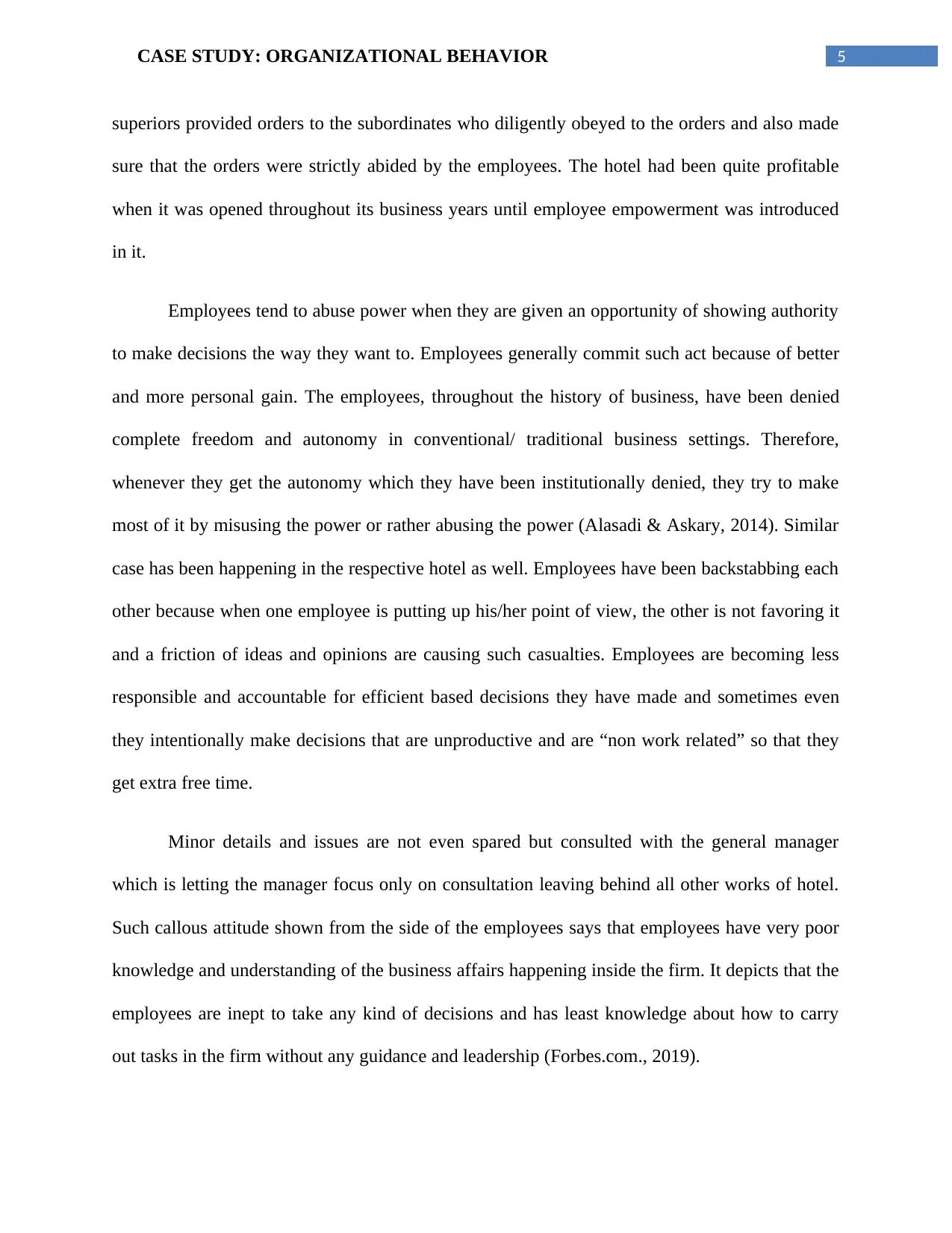
5CASE STUDY: ORGANIZATIONAL BEHAVIOR
superiors provided orders to the subordinates who diligently obeyed to the orders and also made
sure that the orders were strictly abided by the employees. The hotel had been quite profitable
when it was opened throughout its business years until employee empowerment was introduced
in it.
Employees tend to abuse power when they are given an opportunity of showing authority
to make decisions the way they want to. Employees generally commit such act because of better
and more personal gain. The employees, throughout the history of business, have been denied
complete freedom and autonomy in conventional/ traditional business settings. Therefore,
whenever they get the autonomy which they have been institutionally denied, they try to make
most of it by misusing the power or rather abusing the power (Alasadi & Askary, 2014). Similar
case has been happening in the respective hotel as well. Employees have been backstabbing each
other because when one employee is putting up his/her point of view, the other is not favoring it
and a friction of ideas and opinions are causing such casualties. Employees are becoming less
responsible and accountable for efficient based decisions they have made and sometimes even
they intentionally make decisions that are unproductive and are “non work related” so that they
get extra free time.
Minor details and issues are not even spared but consulted with the general manager
which is letting the manager focus only on consultation leaving behind all other works of hotel.
Such callous attitude shown from the side of the employees says that employees have very poor
knowledge and understanding of the business affairs happening inside the firm. It depicts that the
employees are inept to take any kind of decisions and has least knowledge about how to carry
out tasks in the firm without any guidance and leadership (Forbes.com., 2019).
superiors provided orders to the subordinates who diligently obeyed to the orders and also made
sure that the orders were strictly abided by the employees. The hotel had been quite profitable
when it was opened throughout its business years until employee empowerment was introduced
in it.
Employees tend to abuse power when they are given an opportunity of showing authority
to make decisions the way they want to. Employees generally commit such act because of better
and more personal gain. The employees, throughout the history of business, have been denied
complete freedom and autonomy in conventional/ traditional business settings. Therefore,
whenever they get the autonomy which they have been institutionally denied, they try to make
most of it by misusing the power or rather abusing the power (Alasadi & Askary, 2014). Similar
case has been happening in the respective hotel as well. Employees have been backstabbing each
other because when one employee is putting up his/her point of view, the other is not favoring it
and a friction of ideas and opinions are causing such casualties. Employees are becoming less
responsible and accountable for efficient based decisions they have made and sometimes even
they intentionally make decisions that are unproductive and are “non work related” so that they
get extra free time.
Minor details and issues are not even spared but consulted with the general manager
which is letting the manager focus only on consultation leaving behind all other works of hotel.
Such callous attitude shown from the side of the employees says that employees have very poor
knowledge and understanding of the business affairs happening inside the firm. It depicts that the
employees are inept to take any kind of decisions and has least knowledge about how to carry
out tasks in the firm without any guidance and leadership (Forbes.com., 2019).
⊘ This is a preview!⊘
Do you want full access?
Subscribe today to unlock all pages.

Trusted by 1+ million students worldwide
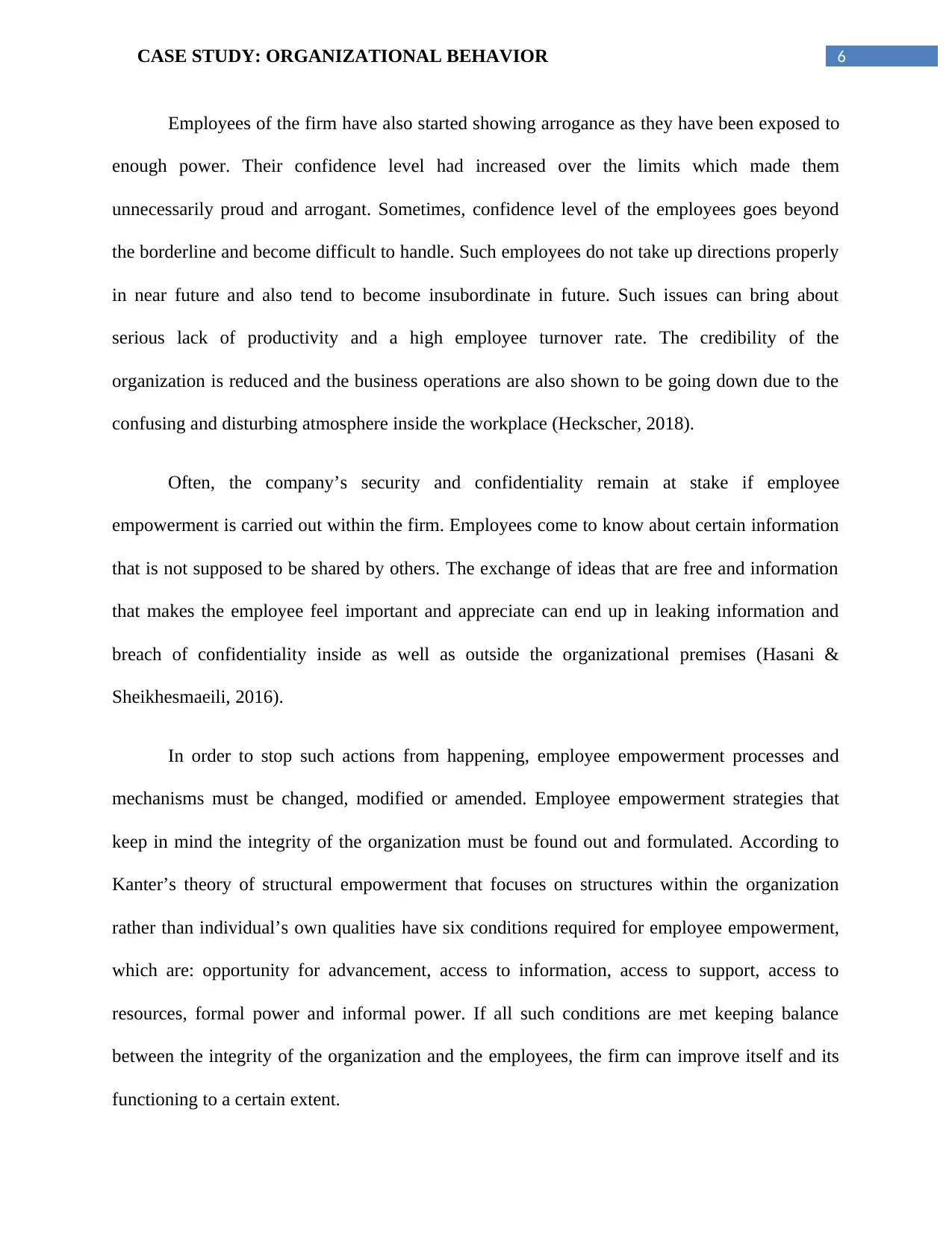
6CASE STUDY: ORGANIZATIONAL BEHAVIOR
Employees of the firm have also started showing arrogance as they have been exposed to
enough power. Their confidence level had increased over the limits which made them
unnecessarily proud and arrogant. Sometimes, confidence level of the employees goes beyond
the borderline and become difficult to handle. Such employees do not take up directions properly
in near future and also tend to become insubordinate in future. Such issues can bring about
serious lack of productivity and a high employee turnover rate. The credibility of the
organization is reduced and the business operations are also shown to be going down due to the
confusing and disturbing atmosphere inside the workplace (Heckscher, 2018).
Often, the company’s security and confidentiality remain at stake if employee
empowerment is carried out within the firm. Employees come to know about certain information
that is not supposed to be shared by others. The exchange of ideas that are free and information
that makes the employee feel important and appreciate can end up in leaking information and
breach of confidentiality inside as well as outside the organizational premises (Hasani &
Sheikhesmaeili, 2016).
In order to stop such actions from happening, employee empowerment processes and
mechanisms must be changed, modified or amended. Employee empowerment strategies that
keep in mind the integrity of the organization must be found out and formulated. According to
Kanter’s theory of structural empowerment that focuses on structures within the organization
rather than individual’s own qualities have six conditions required for employee empowerment,
which are: opportunity for advancement, access to information, access to support, access to
resources, formal power and informal power. If all such conditions are met keeping balance
between the integrity of the organization and the employees, the firm can improve itself and its
functioning to a certain extent.
Employees of the firm have also started showing arrogance as they have been exposed to
enough power. Their confidence level had increased over the limits which made them
unnecessarily proud and arrogant. Sometimes, confidence level of the employees goes beyond
the borderline and become difficult to handle. Such employees do not take up directions properly
in near future and also tend to become insubordinate in future. Such issues can bring about
serious lack of productivity and a high employee turnover rate. The credibility of the
organization is reduced and the business operations are also shown to be going down due to the
confusing and disturbing atmosphere inside the workplace (Heckscher, 2018).
Often, the company’s security and confidentiality remain at stake if employee
empowerment is carried out within the firm. Employees come to know about certain information
that is not supposed to be shared by others. The exchange of ideas that are free and information
that makes the employee feel important and appreciate can end up in leaking information and
breach of confidentiality inside as well as outside the organizational premises (Hasani &
Sheikhesmaeili, 2016).
In order to stop such actions from happening, employee empowerment processes and
mechanisms must be changed, modified or amended. Employee empowerment strategies that
keep in mind the integrity of the organization must be found out and formulated. According to
Kanter’s theory of structural empowerment that focuses on structures within the organization
rather than individual’s own qualities have six conditions required for employee empowerment,
which are: opportunity for advancement, access to information, access to support, access to
resources, formal power and informal power. If all such conditions are met keeping balance
between the integrity of the organization and the employees, the firm can improve itself and its
functioning to a certain extent.
Paraphrase This Document
Need a fresh take? Get an instant paraphrase of this document with our AI Paraphraser
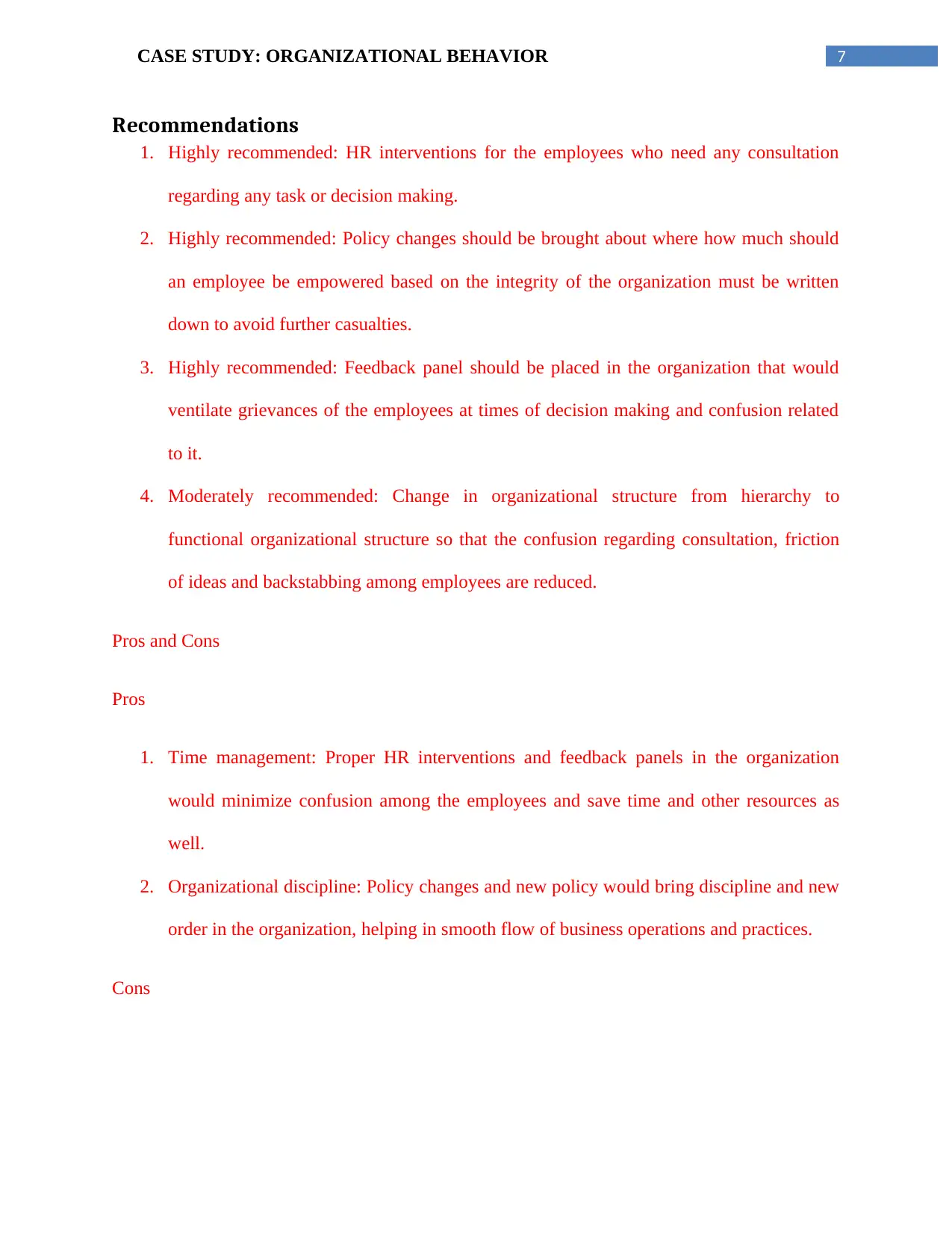
7CASE STUDY: ORGANIZATIONAL BEHAVIOR
Recommendations
1. Highly recommended: HR interventions for the employees who need any consultation
regarding any task or decision making.
2. Highly recommended: Policy changes should be brought about where how much should
an employee be empowered based on the integrity of the organization must be written
down to avoid further casualties.
3. Highly recommended: Feedback panel should be placed in the organization that would
ventilate grievances of the employees at times of decision making and confusion related
to it.
4. Moderately recommended: Change in organizational structure from hierarchy to
functional organizational structure so that the confusion regarding consultation, friction
of ideas and backstabbing among employees are reduced.
Pros and Cons
Pros
1. Time management: Proper HR interventions and feedback panels in the organization
would minimize confusion among the employees and save time and other resources as
well.
2. Organizational discipline: Policy changes and new policy would bring discipline and new
order in the organization, helping in smooth flow of business operations and practices.
Cons
Recommendations
1. Highly recommended: HR interventions for the employees who need any consultation
regarding any task or decision making.
2. Highly recommended: Policy changes should be brought about where how much should
an employee be empowered based on the integrity of the organization must be written
down to avoid further casualties.
3. Highly recommended: Feedback panel should be placed in the organization that would
ventilate grievances of the employees at times of decision making and confusion related
to it.
4. Moderately recommended: Change in organizational structure from hierarchy to
functional organizational structure so that the confusion regarding consultation, friction
of ideas and backstabbing among employees are reduced.
Pros and Cons
Pros
1. Time management: Proper HR interventions and feedback panels in the organization
would minimize confusion among the employees and save time and other resources as
well.
2. Organizational discipline: Policy changes and new policy would bring discipline and new
order in the organization, helping in smooth flow of business operations and practices.
Cons
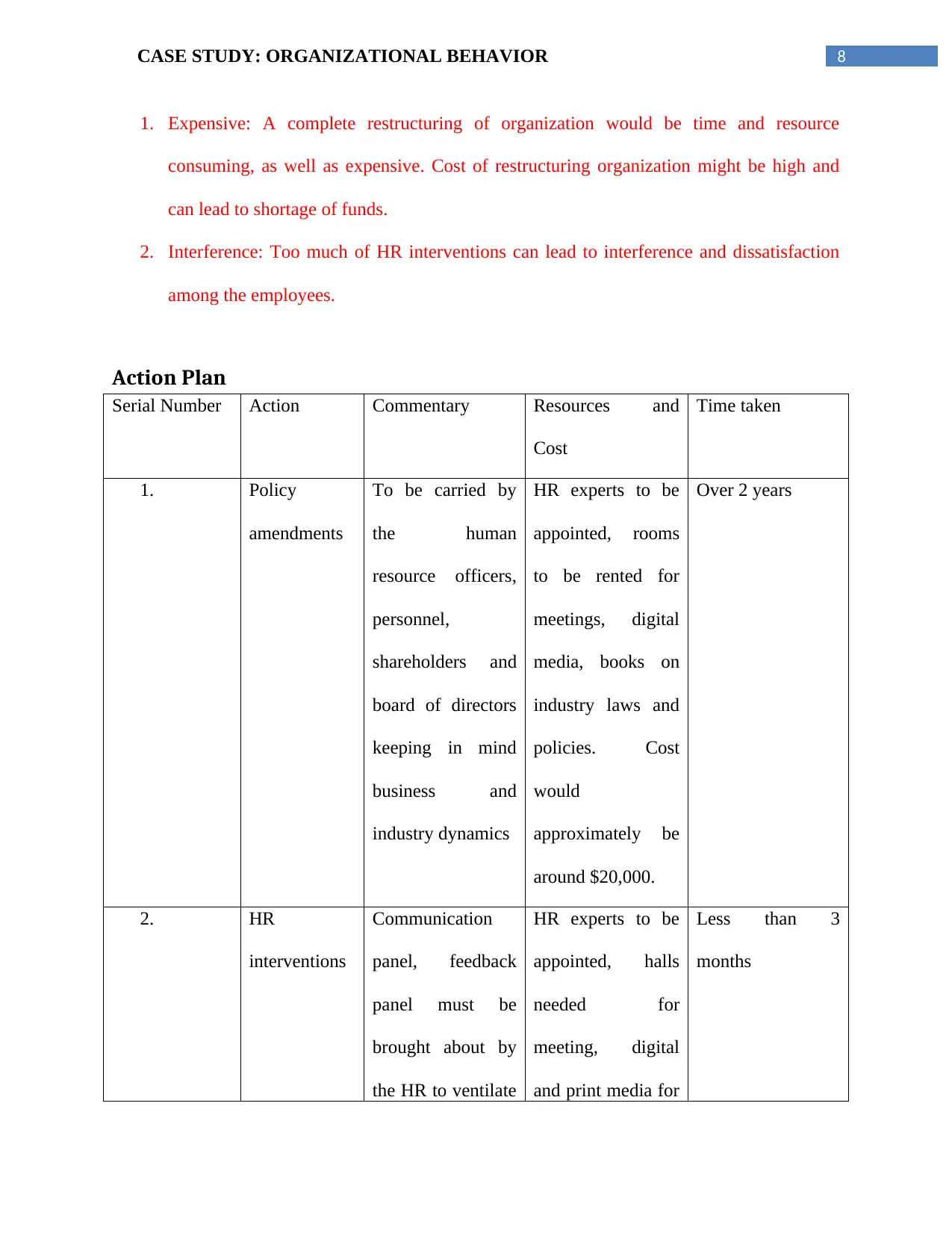
8CASE STUDY: ORGANIZATIONAL BEHAVIOR
1. Expensive: A complete restructuring of organization would be time and resource
consuming, as well as expensive. Cost of restructuring organization might be high and
can lead to shortage of funds.
2. Interference: Too much of HR interventions can lead to interference and dissatisfaction
among the employees.
Action Plan
Serial Number Action Commentary Resources and
Cost
Time taken
1. Policy
amendments
To be carried by
the human
resource officers,
personnel,
shareholders and
board of directors
keeping in mind
business and
industry dynamics
HR experts to be
appointed, rooms
to be rented for
meetings, digital
media, books on
industry laws and
policies. Cost
would
approximately be
around $20,000.
Over 2 years
2. HR
interventions
Communication
panel, feedback
panel must be
brought about by
the HR to ventilate
HR experts to be
appointed, halls
needed for
meeting, digital
and print media for
Less than 3
months
1. Expensive: A complete restructuring of organization would be time and resource
consuming, as well as expensive. Cost of restructuring organization might be high and
can lead to shortage of funds.
2. Interference: Too much of HR interventions can lead to interference and dissatisfaction
among the employees.
Action Plan
Serial Number Action Commentary Resources and
Cost
Time taken
1. Policy
amendments
To be carried by
the human
resource officers,
personnel,
shareholders and
board of directors
keeping in mind
business and
industry dynamics
HR experts to be
appointed, rooms
to be rented for
meetings, digital
media, books on
industry laws and
policies. Cost
would
approximately be
around $20,000.
Over 2 years
2. HR
interventions
Communication
panel, feedback
panel must be
brought about by
the HR to ventilate
HR experts to be
appointed, halls
needed for
meeting, digital
and print media for
Less than 3
months
⊘ This is a preview!⊘
Do you want full access?
Subscribe today to unlock all pages.

Trusted by 1+ million students worldwide
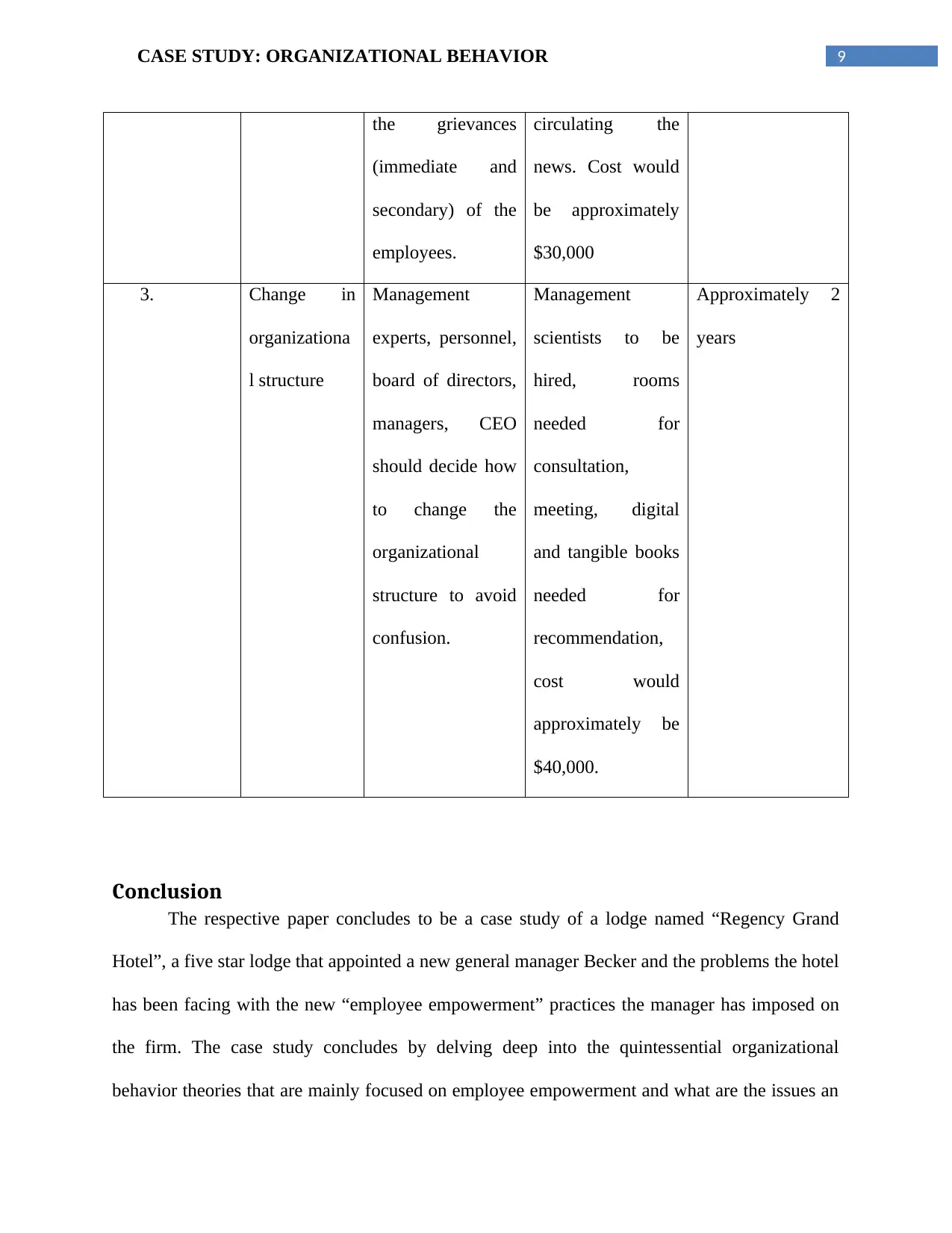
9CASE STUDY: ORGANIZATIONAL BEHAVIOR
the grievances
(immediate and
secondary) of the
employees.
circulating the
news. Cost would
be approximately
$30,000
3. Change in
organizationa
l structure
Management
experts, personnel,
board of directors,
managers, CEO
should decide how
to change the
organizational
structure to avoid
confusion.
Management
scientists to be
hired, rooms
needed for
consultation,
meeting, digital
and tangible books
needed for
recommendation,
cost would
approximately be
$40,000.
Approximately 2
years
Conclusion
The respective paper concludes to be a case study of a lodge named “Regency Grand
Hotel”, a five star lodge that appointed a new general manager Becker and the problems the hotel
has been facing with the new “employee empowerment” practices the manager has imposed on
the firm. The case study concludes by delving deep into the quintessential organizational
behavior theories that are mainly focused on employee empowerment and what are the issues an
the grievances
(immediate and
secondary) of the
employees.
circulating the
news. Cost would
be approximately
$30,000
3. Change in
organizationa
l structure
Management
experts, personnel,
board of directors,
managers, CEO
should decide how
to change the
organizational
structure to avoid
confusion.
Management
scientists to be
hired, rooms
needed for
consultation,
meeting, digital
and tangible books
needed for
recommendation,
cost would
approximately be
$40,000.
Approximately 2
years
Conclusion
The respective paper concludes to be a case study of a lodge named “Regency Grand
Hotel”, a five star lodge that appointed a new general manager Becker and the problems the hotel
has been facing with the new “employee empowerment” practices the manager has imposed on
the firm. The case study concludes by delving deep into the quintessential organizational
behavior theories that are mainly focused on employee empowerment and what are the issues an
Paraphrase This Document
Need a fresh take? Get an instant paraphrase of this document with our AI Paraphraser
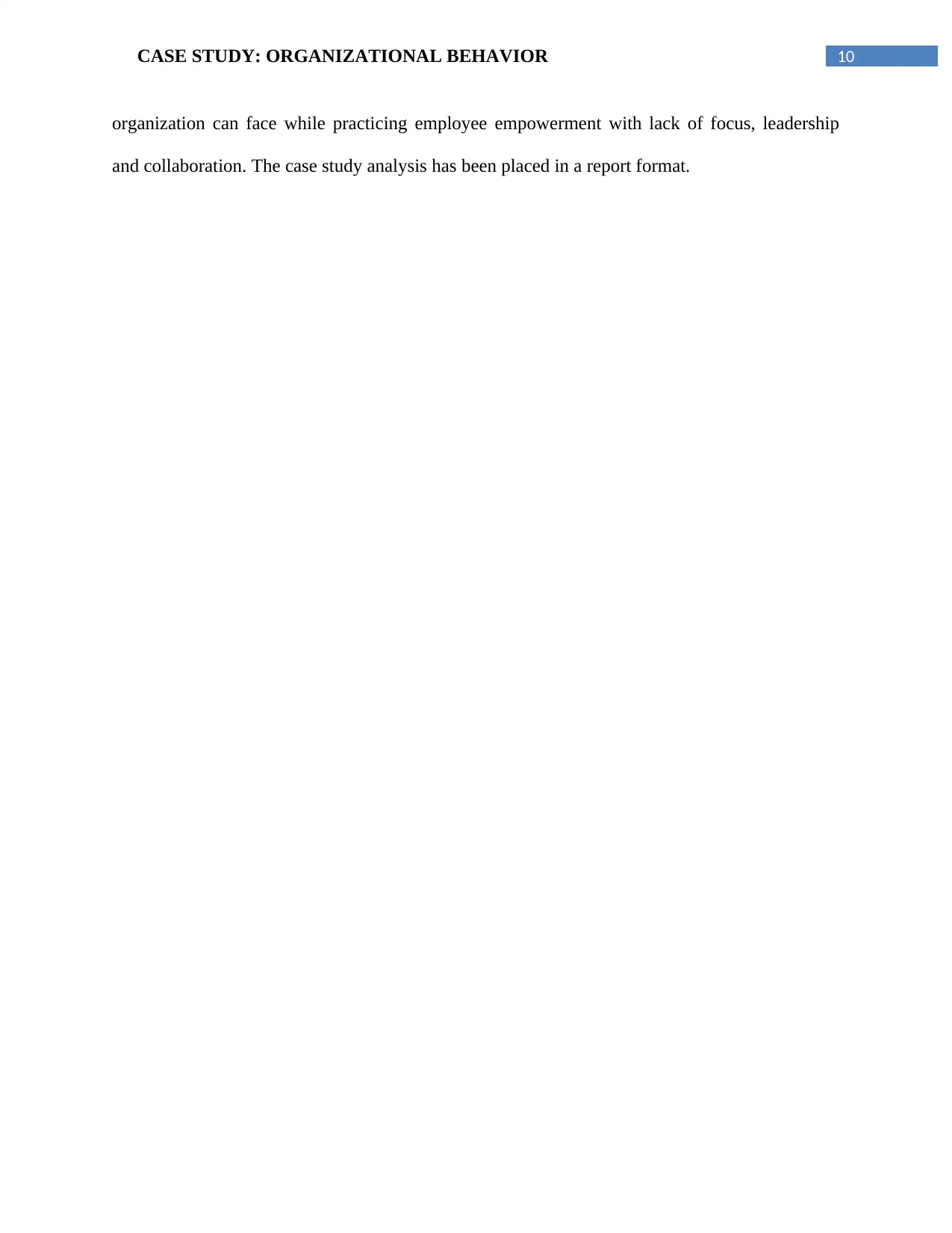
10CASE STUDY: ORGANIZATIONAL BEHAVIOR
organization can face while practicing employee empowerment with lack of focus, leadership
and collaboration. The case study analysis has been placed in a report format.
organization can face while practicing employee empowerment with lack of focus, leadership
and collaboration. The case study analysis has been placed in a report format.
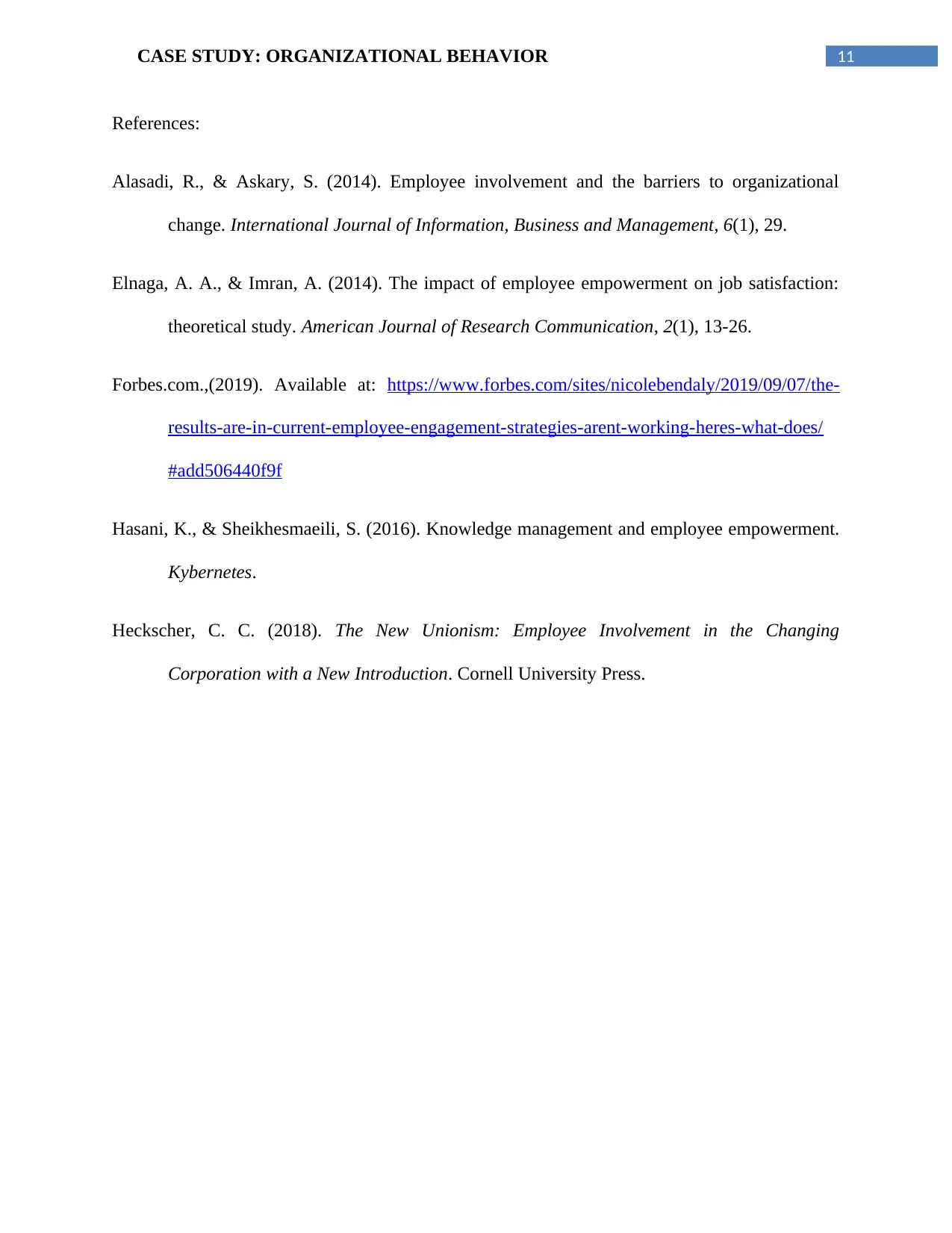
11CASE STUDY: ORGANIZATIONAL BEHAVIOR
References:
Alasadi, R., & Askary, S. (2014). Employee involvement and the barriers to organizational
change. International Journal of Information, Business and Management, 6(1), 29.
Elnaga, A. A., & Imran, A. (2014). The impact of employee empowerment on job satisfaction:
theoretical study. American Journal of Research Communication, 2(1), 13-26.
Forbes.com.,(2019). Available at: https://www.forbes.com/sites/nicolebendaly/2019/09/07/the-
results-are-in-current-employee-engagement-strategies-arent-working-heres-what-does/
#add506440f9f
Hasani, K., & Sheikhesmaeili, S. (2016). Knowledge management and employee empowerment.
Kybernetes.
Heckscher, C. C. (2018). The New Unionism: Employee Involvement in the Changing
Corporation with a New Introduction. Cornell University Press.
References:
Alasadi, R., & Askary, S. (2014). Employee involvement and the barriers to organizational
change. International Journal of Information, Business and Management, 6(1), 29.
Elnaga, A. A., & Imran, A. (2014). The impact of employee empowerment on job satisfaction:
theoretical study. American Journal of Research Communication, 2(1), 13-26.
Forbes.com.,(2019). Available at: https://www.forbes.com/sites/nicolebendaly/2019/09/07/the-
results-are-in-current-employee-engagement-strategies-arent-working-heres-what-does/
#add506440f9f
Hasani, K., & Sheikhesmaeili, S. (2016). Knowledge management and employee empowerment.
Kybernetes.
Heckscher, C. C. (2018). The New Unionism: Employee Involvement in the Changing
Corporation with a New Introduction. Cornell University Press.
⊘ This is a preview!⊘
Do you want full access?
Subscribe today to unlock all pages.

Trusted by 1+ million students worldwide
1 out of 12
Related Documents
Your All-in-One AI-Powered Toolkit for Academic Success.
+13062052269
info@desklib.com
Available 24*7 on WhatsApp / Email
![[object Object]](/_next/static/media/star-bottom.7253800d.svg)
Unlock your academic potential
Copyright © 2020–2025 A2Z Services. All Rights Reserved. Developed and managed by ZUCOL.





